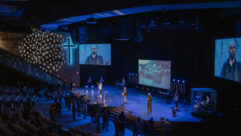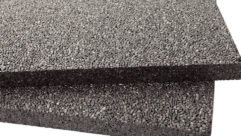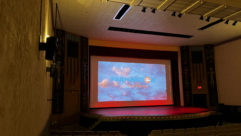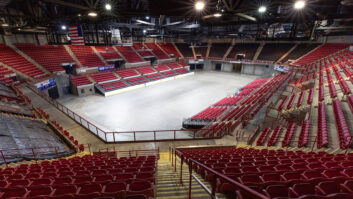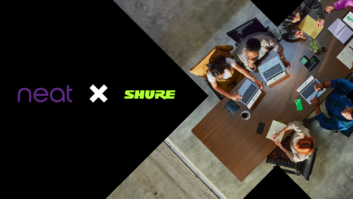
Small Auditorium Sound, Part 1
Jun 4, 2012 2:58 PM
Listen to the Podcasts
Editor’s note: For your convenience, this transcription of the podcast includes timestamps. If you are listening to the podcast and reading its accompanying transcription, you can use the timestamps to jump to any part of the audio podcast by simply dragging the slider on the podcast to the time indicated in the transcription.

Cramton Auditorium on the campus of Washington, DC’s Howard University has seen a huge variety of performances and its recent complete renovation included L-Acoustics speaker arrays and amplification installed by RCI Systems. Bob Capotosto and Gene Ingham are here to tell us all about it, coming right up on the SVC Podcast.
Bob and Gene, it’s great to have you with us on the SVC Podcast from RCI Systems in Beltsville, Md. I know you’ve got a lot going on there so what all does RCI Systems do?
Gene: Well primarily we’re an event production company and we provide audio, video, lighting for special events, corporate events, things of that nature and then obviously our side of the business is the integration side where we do design and installation of the audio, video and various control systems. [Timestamp: 1:15]
And with the way the AV technology is changing and integrating IT that’s always something to stay on top of. You got into the Cramton Auditorium at Howard University in Washington, DC. I know that has a lot of different performers, it’s a busy place and so you did a big sound system upgrade there so tell me about Cramton Auditorium.
Gene: Well the auditorium was originally opened in 1961, recently renovated for the 50th anniversary and it’s been the host for speaking events, theatrical productions and concerts as well as handling all their scholastic and church events. [Timestamp: 1:48]
And they’ve got music acts and they’ve got debates and lots of other things so the sound system has to be able to handle a lot of things. So what exactly did they say they needed from this project?
Gene: Well it was a complete building renovation along with power and they wanted to include the audio system upgrade. One of the major problems was that production was being brought in for every show which added to their bottom line cost. The existing system had poor coverage and intelligibility issues. [Timestamp: 2:18]
And when you have to set up everything temporarily for every different event, it’s not going to be nearly as reliable as a permanently installed system either.
Gene: Right, you never know what you’re going to get from show to show. [Timestamp: 2:27]
Why did you decide to go with the L-Acoustics system for this one?
Bob: Well in our meetings that we have with the university we reviewed various writers that they had done in the past and with the various acts and the decision was made to proceed with the L-Acoustics solution primarily based on writer’s acceptability and then we looked at the cost and the product life cycle and that pretty much made the decision for the university for the return on investment. [Timestamp: 2:59]
Small Auditorium Sound, Part 1
Jun 4, 2012 2:58 PM

Had you used L-Acoustics systems or components before?
Bob: I’ve been familiar with L-Acoustics for several years even with my previous employer so when I got to RCI a few years ago I was pretty much up on the product and what was going on and had a relationship with those guys so this was a good fit. [Timestamp: 3:16]
OK now they were doing a complete renovation so did you have any production or things scheduled that you had to sort of squeeze in between to get this one done?
Gene: Well, we sure did and because we have a production background we were able to anticipate that and the only headache we had was having to ground stack it between the time the I-beams were put in. [Timestamp: 3:38]
In a renovation project of this size you can get everything waiting on something else of course, if things aren’t done in the right order.
Bob: Well that does happen and—but we were, like I said, Gene had said we’re pretty well versed in production requirements and between our experience and the local production staff we were able to navigate through construction rather well. They didn’t have any real hiccups in any of their production that they had put together during the renovation process so it did go rather smoothly. [Timestamp: 4:07]
Now the Cramton Auditorium’s been around for a good while. How are the acoustics in there? Were there any acoustical issues to deal with?
Bob: No there really weren’t any acoustical challenges in this project. I think the main thing was were sight lines that we had to deal with which is usually an issue in a theater and our main focus with this particular situation was to make sure that we had the direct energy on the seats and we were able to basically steer the energy off the walls with the L-Acoustics product. [Timestamp: 4:36]
Were there any architectural modifications you had to do to support the equipment or any kind of rigging challenges or anything like that?
Gene: Oh, there were absolutely—we had, we didn’t have any kind of structural steel to fly this rig off of so when we did the initial modeling in Soundvision I was able to pull the mechanicals off of that and we had to work with the structural engineer and they had to actually install steel above the ceiling and all those modifications had to be done through the structural engineers, signed off obviously before we could load them. But we just worked real well with the structural engineer on this. [Timestamp: 5:12]
Well at least that way you know exactly what’s there.
Gene: Oh most definitely. I mean the structural engineer was on site for elevators and everything else for the inspections during the construction phase so it really wasn’t a problem. [Timestamp: 5:35]
And the L-Acoustics gear. What particular model was this, the Kudo system?
Gene: Yes. This was the Kudo boxes. [Timestamp: 5:30]
OK now how do you adjust the mid and high frequency directivity on the Kudo boxes, since you had to make those adjustments. How did you do that on those?
Gene: Well on the Kudo, it primarily has the louvers so when you do the modeling in the L-Acoustics Soundvision software you’re able to model it with the louvers in various positions so the louvers were an integral part in keeping that energy off the walls so it worked out real well in this situation. [Timestamp: 5:56]
And you just take the information from the software app and set everything?
Gene: Once you do the model you know what the position of each louver in the box should be so you just set them right on the ground and as they go up you pin them and you’re done. It’s rather painless. [Timestamp: 6:12]
And the system in that particular venue has to be ready for just about anything. But it sounds like it went OK in fact you guys make it sound almost like it was too easy.
Gene: I wouldn’t say too easy but you know, you have your days but all in all it turned out extremely well. [Timestamp: 6:27]
Well, in part two we’ll get into some of the other L-Acoustics gear you installed but I appreciate your being here for Part 1. Bob Capotosto and Gene Ingham from RCI Systems. A great installation job at Howard University’s Cramton Auditorium and we’ll talk more about it in part two.
Thanks for joining us for the SVC Podcast with Bob Capotosto and Gene Ingham of RCI Systems. Show notes can be found on the website of Sound & Video Contractor Magazine at svconline.com. In part two, Bob and Gene get into how they used the L-Acoustics 8XTi enclosures and SB28 subs, next time on the SVC Podcast.



